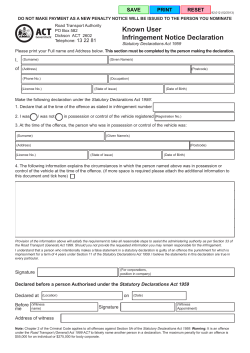
SOA 2010 Life & Annuity Symposium May 17-18, 2010
SOA 2010 Life & Annuity Symposium May 17-18, 2010 Session 23 PD, What is the 'X-factor'? Moderator: Philip Ferrari, ASA, MAAA Presenters: Michael Andrew Fox, FSA, MAAA Michael J. LeBoeuf, FSA, MAAA 2010 LAS – S i 23 Session 23: What is the X-Factor? A global expert services company providing expert testimony, authoritative studies, and strategic advisory services to clients including Fortune Global 500 corporations, major law firms, and governments worldwide. www.lecg.com 2 Panel and Structure • Introductions • Phil Ferrari • LECG-SMART • Michael LeBoeuf • LECG-SMART • Michael Fox • Protective Life • Session structure 1 2010 LAS – Session 23: What is the X-Factor? Phil Ferrari, ASA, MAAA Senior Manager and Actuary LECG-SMART A global expert services company providing expert testimony, authoritative studies, and strategic advisory services to clients including Fortune Global 500 corporations, major law firms, and governments worldwide. www.lecg.com 4 Regulation XXX • Purpose • Long duration Term and Secondary Guarantee Universal Life • 19 year select factors for 1980 CSO table • Several new valuation ideas • Main focus was option to use expected mortality assumptions in the calculation of deficiency reserves • Customized assumptions through the use of “X-factors” • Actuarial opinion and supporting report • Appointed actuary obligated to provide if X-factors utilized • Annual demonstration and opining 2 5 The X-factor • “X% of the selection factors” • Apply an additional factor to the select factors introduced by XXX • Chosen by appointed actuary • Can vary y byy anything y g affecting g mortality y • policy year, policy form, class • Should reflect credible mortality experience • Can add explicit margin for conservatism 6 The X-factor • Main requirements • • • • • Used for first segment defined using deficiency reserve mortality 20% floor Non-decreasing requirement APV of deficiency reserve mortality >= APV of expected mortality X-factor morality > = expected mortality • Joint life policies • Involved process to determine X-factors • Reinsurance • Ceding company X-factors vs. assuming reinsurer 3 7 Practical Issues • Quantifying emerging mortality • Mortality studies are not prevalent in the industry • Where conducted, actuarial resources are often limited • Could outsource or use a company’s reinsurer • On-going analysis • Annual statistical demonstration of appropriateness pp p • Hypothesis testing a popular method • Must determine aggregate distribution of claims, e.g. Monte Carlo • By X-factor class and overall X-factor classes combined • If actual amount of claims exceeds amount under aggregate distribution and confidence level chosen, X-factor is rejected 8 Practical Issues (cont.) • Changes to future X-factor mortality • If X-factors rejected, X-factor mortality must be increased for classes of failure • Opinion and Report Development • Annual preparation • Full documentation of work supporting conclusions • All requirements of regulation met 4 Session 23 – What is the X-factor? Current Stat and Tax Issues Michael LeBoeuf, FSA, MAAA Managing Director LECG-SMART A global expert services company providing expert testimony, authoritative studies, and strategic advisory services to clients including Fortune Global 500 corporations, major law firms, and governments worldwide. www.lecg.com 10 Current Statutory Developments • Limitations on X-factors in Section 5 of Valuation Model Regulation 830 eliminated • No more 20% floor • X-factor can decrease duration by duration • Should eliminate most, but not all, deficiency reserves • If adopted by companies • Effective for 12/31/2009 5 11 Reasons for Change • It is believed that deficiency reserves are redundant and have been supplanted by asset adequacy analysis • Change does not eliminate deficiency reserves 12 Impact of Change • American Council of Life Insurers Study • Estimated decrease in reserves of $2 - $3 billion • Reduction in deficiency reserves, if any, should be reported as change in valuation method • Report in Exhibit 5A of annual statement • Will be reflected as a release into surplus • Not an increment to operating earnings 6 13 Impact on Taxes • We do not use X-factors or select factors to compute tax reserves, so how does this X-factor change impact taxes? • The statutory cap 14 Impact on Taxes • For many term insurance products, seriatim tax reserves are lower than statutory reserves • So deductibility is capped at the reported statutory level. • The statutory cap should also include any deficiency reserves • Somewhat controversial • IRC defines statutory reserves as amount set forth in annual statement - IRC 807(d)(6) 7 15 Impact on Taxes • Nevertheless even considering deficiency reserves, tax reserves are often capped at statutory levels. • The changes to X-factors end up representing a weakening of the statutory reserves, and th f therefore th the statutory t t t cap. • How does that impact taxes? 16 Impact on Taxes • Should the reserve weakening, which only impacts the statutory cap be subject to a 10 year spread rules IRC Section 807(f)? • No, we have not changed the basis for computing the tax reserve • Yes, the statutory cap is a component of the basis of computing tax reserves 8 17 Impact on Taxes • Which is correct? • Notice 2010-29 • Deals with VA CARVM (Actuarial Guideline XLIII) • Section 3.04 calls for a 10 year spread • Implementation of new guideline has resulted in reserve increases and decreases depending on mix of business inforce 18 Example 1 Year End Statutory Reserves 2008 150 million 2009 185 million 2010 Restated Statutory Reserve Tax Reserve 160 million 175 million 195 million 200 million 215 million 9 19 Example 1 • If we do not consider the change reserve weakening then we have a 2009 statutory reserve increase of $25 million (175 – 150) • If we consider the change reserve weakening then we have a 2009 statutory (tax) reserve increase of $ $35 million ((185 – 150)) • Opening reserve for 2010 is $175 million • Amortization of $10 million of reserve weakening begins in the 2010 return and runs through 2019 20 Example 1 • 2010 increase in tax reserves will be $25 million (200 – 175) • $1 million of the reserve weakening flows into income beginning this taxable year and continues for following 9 years 10 21 Example 2 Year End Statutory Reserves 2008 150 million 2009 135 million 2010 Restated Statutory Reserve Tax Reserve 160 million 130 million 145 million 120 million 130 million 22 Example 2 • If we do not consider the change reserve weakening then we have a 2009 statutory reserve decrease of $20 million (150 – 130) • If we consider the change reserve weakening then we have a 2009 statutory (tax) reserve decrease of $ $15 million ((150 – 135)) • Opening reserve for 2010 is $130 million • Amortization of $5 million of reserve weakening begins in the 2010 return 11 23 Example 2 • 2010 decrease in tax reserves will be $10 million (130 – 120) • $0.5 million of the reserve weakening begins this taxable year and continues for following 9 years. 24 Conclusion • If the reserve change is considered an IRC Section 807(f) change in basis, then the weakening will defer federal income taxes for the company 12 What is the ‘X-Factor’? May 17, 2010 Michael Fox Fox, FSA FSA, MAAA nd 2 Vice President Protective Life Insurance What is the ‘X-Factor’? Practical considerations regarding X-factors X-factor development p X-factor certification 1 What is the ‘X-Factor’? X-factor development Pricing g or valuation? Define X-factor classes Mortality experience Credibility Relevance What is the ‘X-Factor’? X-factor development Use of PAD? Preliminary testing for compliance Sensitivity of reserves to X-factors 2 What is the ‘X-Factor’? X-factor certification Timing g of testing g / certification Methodology used Software used Changes to X X-factors factors Questions? 3
© Copyright 2025












